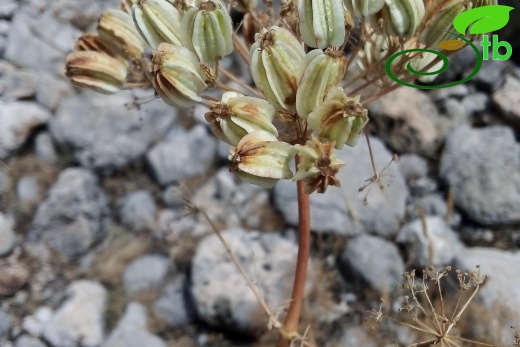Prangos munzurensis
Prangos munzurensis
Munzur çakşırı
Polycarpic, herbaceous plants with thick taproot 30–35 mm. Stems erect, 70–100 cm tall and up to c. 20 mm ⌀ at base, single or several, plump, angular, slightly ribbed, entirely scabrous, with branches directed from all nodes, covered with remains of petioles and sheaths. Basal leaves forming rosette; petioles up to 12 cm long, with developed sheaths at base, minutely scabrous; leaf blades 23–30 cm long, 18–27 cm wide, triangular or rhombic, 4–6 times pinnate, ±densely scabrous; primary leaf segments with petiolules up to 5 cm long; terminal lobes 1–3 cm long, 0.5–0.7 mm wide, close to filiform, acute. Stem leaves significantly smaller than basal ones, with narrow sheaths 15–17 mm long, 2–3 times pinnate, with subfiliform leaf lobes up to 5 cm long; terminal umbels up to 15 cm ⌀, with 16–20 thickened, scabrous, sometimes unequal rays 4–7 cm long; number of bracts 7–10, lanceolate-filiform, with white margins, scabridulous at base, up to 2 cm long. Umbellets up to 5 cm , consisting of 8–12 flowers with unequal pedicels slightly thickened, 9–13 mm long, terete, sparsely scabridulous; number of bracteoles 4–5, linear, entire, with white margins, up to 1 cm long. Calyx teeth obscure. Petals yellow, lanceolate, with narrow, long, declinate top, puberulous, up to 1.5 mm long. Mericarps elliptic or ovate , 11–15 × 5–7 mm; carpophore bifurcate to base; mericarps homomorphic, elliptic, glabrous; only primary ribs present; all ribs straight or slightly undulate, with entire margins, subequal, short protuberance at their base; furrows between ribs narrow, outgrowths absent; stylopods flat or slightly concave; commissure intermediate, exocarp consisting of small cells; mesocarp divided into outer “epimesocarp” and inner mesocarp; inner mesocarp divided into 5 parts, basal parts connected at base; “epimesocarp” consisting of parenchymatous, non-lignified cells; inner mesocarp layer consisting of parenchymatous cells with thickened pore walls; vascular bundles thin, situated in inner mesocarp layer; vittae thin, multiple, near endocarp forming cycle, vallecular and commissural vittae absent; rib of secretory ducts solitary; endocarp and seed coat consisting of small cells, hardly separated; endosperm with mushroom-like groove at commissural side.
Endemic.













